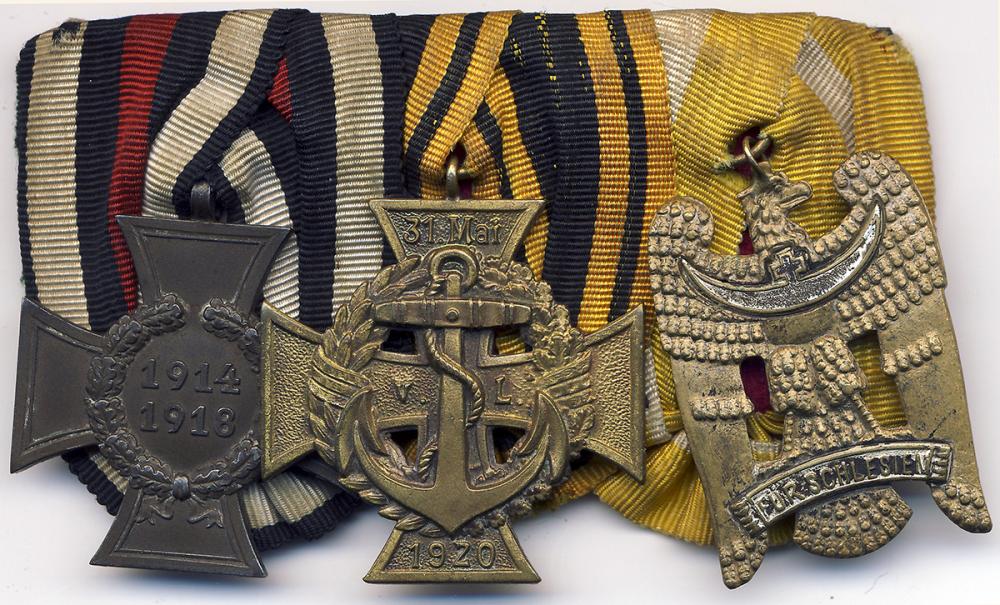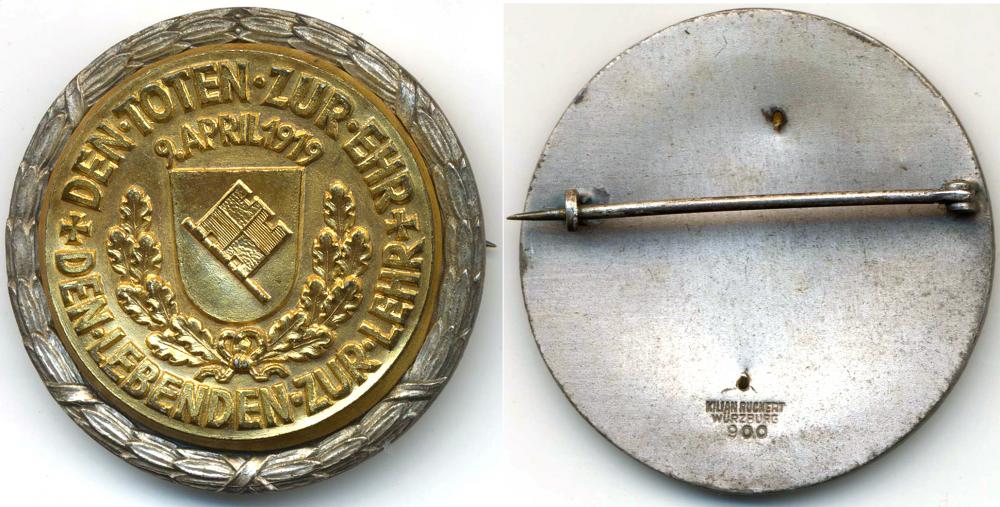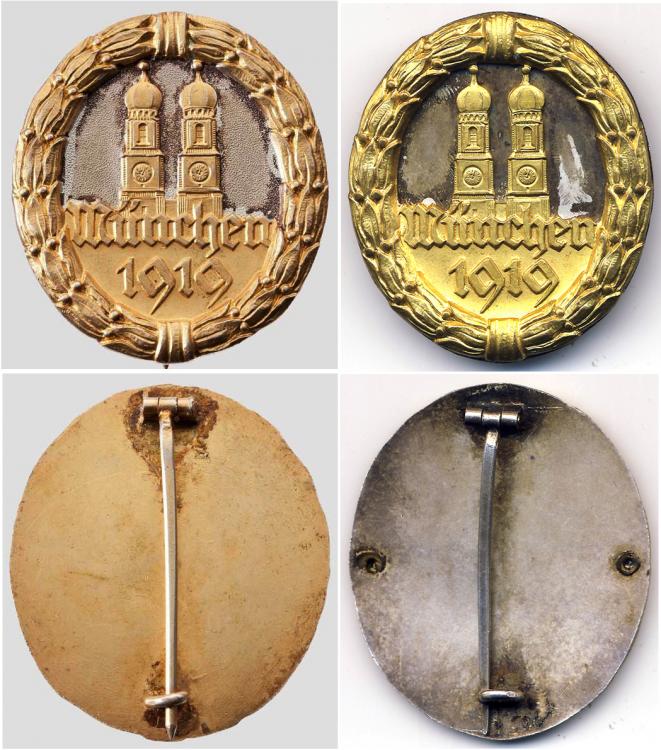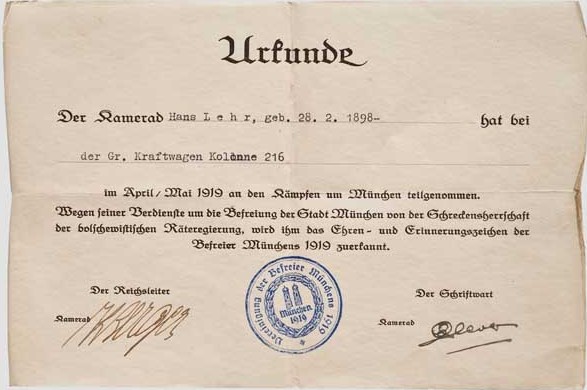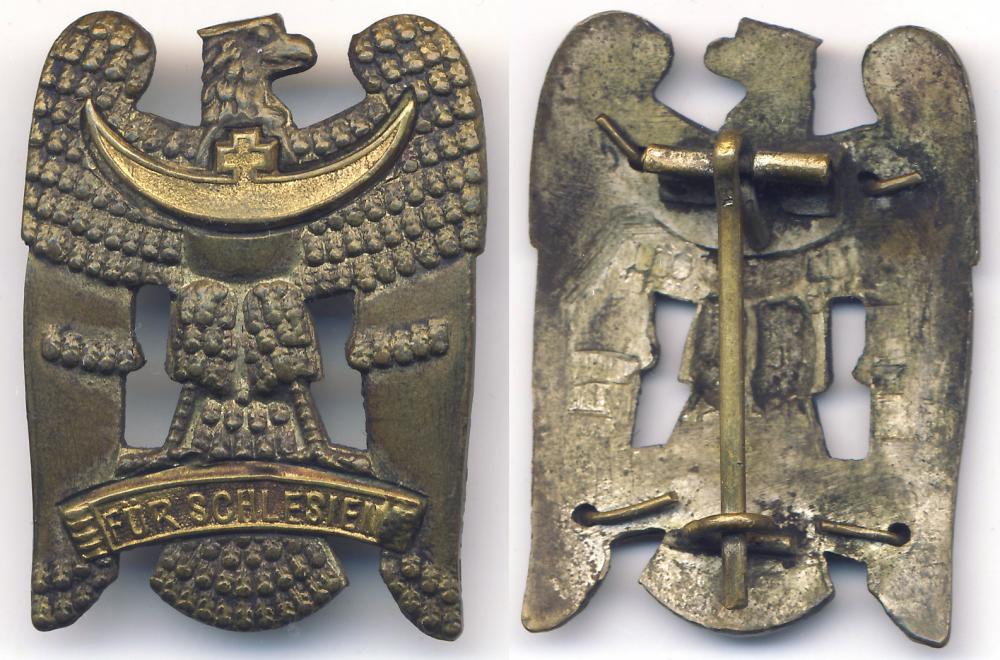
bolewts58
Active Contributor-
Posts
598 -
Joined
-
Last visited
-
Days Won
9
Content Type
Profiles
Forums
Blogs
Gallery
Events
Store
Everything posted by bolewts58
-
German patriotic insignia
bolewts58 replied to WJT's topic in Germany: Weimar Republic & Deutsche Freikorps
You're in the wrong forum. This should have been posted on the Germany: Imperial: The Orders, Decorations and Medals of The Imperial German States forum. The first one is the Deutscher Krieger Bund which was formed in 1876 as a national veteran's association for enlisted men. The metal suspender was generic and was usually customized with a local chapter's membership cross or medal. The cross on yours is likely some sort of generic patriotic commemorative, maybe in honour of Wilhelm II's assession to the throne in 1888, or is maybe just some sort of loyalty cross. The trifold ribbon could have been used for any number of patriotic medals. It's hard to say. -
I've lived in Thailand (mainly Bangkok) for nearly 20 years, off an on. Thais don't collect military medals and therefore, there really isn't anywhere to buy them. Occasionally, some turn up in the handful of coin and stamp shops that exist (mostly in the old city on Rattanakosin island and along Charoenkrung Road near the old post office.). But, rarely is there anything of interest. There used to be a place called the Thieves Market that had odd bits and pieces of military surplus. But, I doubt there's much there, now. if you have time to take some short trips in the region, you might still find the odd thing in Georgetown, Penang, Malaysia, Hanoi (lots of Viet repros, though) or in Singapore. But, in general, Asia is not really the place to look for militaria. There's just no interest. I rely on my network of collector friends, eBay, auctions and dealers for my collection.
-
Saxon Eastern Front Cross
bolewts58 replied to Robin Lumsden's topic in Germany: Weimar Republic & Deutsche Freikorps
I hope they give you your money back. They aren't exactly known to be very receptive to refunds. -
For your viewing pleasure.
bolewts58 replied to CRBeery's topic in Germany: Weimar Republic & Deutsche Freikorps
-
Saxon Eastern Front Cross
bolewts58 replied to Robin Lumsden's topic in Germany: Weimar Republic & Deutsche Freikorps
Is this one yours? Also, who was seller? This is important? The picture you originally posted from eBay with the marble background and poor lighting is typical of those regularly posted by the group of fakers who originated in Aaachen, but who are in other locals like Cologne. -
Saxon Eastern Front Cross
bolewts58 replied to Robin Lumsden's topic in Germany: Weimar Republic & Deutsche Freikorps
I have my doubts because these are widely faked to a very high degree and routinely sold by "the Club" and its minions. Can you show close-up details of the dates and also the reverse, please? Also, what was the name of the seller? -
I have gotten carried away a few times on WAF and I have admitted as such and apologized when I have crossed the line. The few times I have been guilty of this, I have accepted criticism for it. I haven't denigrated this forum, so much as to point out perhaps not in the most eloquent of terms, the difference between it and WAF, as others have done as well: that GMIC is scholarly, but sometimes a bit highbrow and stuffy (not necessarily a bad thing) and WAF is more of an everyman forum. Just my opinion and nothing more, but an opinion that has been expressed by others. I admit I have strong opinions. But, I think I express them for the most part politely and have imparted a considerable amount of valuable information over the years. I have obviously rubbed you the wrong way. But, if I was the bully you say I am, I would have been banned from WAF. I hardly ever post here. So, I don't think, unless I'm mistaken that I've said much untoward to anyone here. But, if I have, I apologize. Perhaps, I'll just stick to WAF and not post here anymore. I stand corrected on this and agree with Chris that sadly document groups get more when they are broken up.
-
I sent him a message condemning him for his stupidity with a link to this thread. The irony is that in some ignorant attempt to make more money he failed to realize that the group intact would garner more money than the sum of it ripped apart pieces. Unfortunately, eBay has more than its fair share of imbeciles and charlatans.
-
Freikorps Ribbon Bar
bolewts58 replied to webr55's topic in Germany: Weimar Republic & Deutsche Freikorps
Freikorps ribbon bars like those shown above, of anything beyond the Silesian Eagle and Baltic Cross are extremely difficult to find because of the refitting done in 1934-35 which saw the banning of most Freikorps awards. I recently picked up this gem in an eBay job-lot, unrecognized by the seller. Rare Feldspange of the Freiwillige Russische Westarmee Ribbons as follows: EKII, Maltese Cross of the Russian West-Army (Avalov Cross), Baltic Cross, Russian George Cross IV class -
Weimar time medal bars
bolewts58 replied to Claudio's topic in Germany: Weimar Republic & Deutsche Freikorps
Yes. Can we see the back? The ribbons are sort of folded in a Southern German style, but in a rather messy way and seem rather loose. Maybe some red flags here. -
Schutztruppe Bug + Bug-Stern
bolewts58 replied to wolfsbur's topic in Germany: Weimar Republic & Deutsche Freikorps
A nice set for a very good price. The Honour Certificates are hard to come by and that variation on the Bug Stern is not common, either. -
The "Last" Freikorps Award
bolewts58 posted a topic in Germany: Weimar Republic & Deutsche Freikorps
For years, it was generally thought that the last Freikorps award was the "Commemorative Badge of the City of Würzburg" (Erinnerungsplakette der Stadt Würzburg) shown (below top) given to members of Freikorps Würzburg in 1934 on the 15th anniversary of its formation. Freikorps Würzburg was formed from the Bavarian Reserve Jäger Regiment 15 that returned to Germany from Georgia in April 1919 after a long sea voyage by British merchant ship from the Black Sea to northern Germany and a train journey south to Bavaria. Bavarian Reserve Jäger Regiment 15 literally arrived at the Würzburg train station after their very circuitous and arduous return home and immediately volunteered to form Freikorps Würzburg, got back on the train and headed to Munich to join other Freikorps already taking up positions outside the city. It took part in the heavy fighting in Munich against the Munich Soviet Republic on May 2-3, 1919. Subsequently, Freikorps awards were prohibited for wear by active members of the German Armed Forces from 1935 onwards and it was generally thought that this therefore was the last official Freikorps award. However, another Freikorps award, instituted in 1937, two years after the prohibition date has come to light, and therefore replaces the Freikorps Würzburg badge as the likely candidate for the last Freikorps award. The "Honor and Commemorative Badge for the Liberators of Munich 1919" (Ehren- und Erinnerungszeichen der Befreier Münchens 1919) has been known about for some time, but wrongly identified until recently. There are two minor variations of the badge shown here (below bottom). The one on the right is from my collection and the one on the left is currently up for auction at Herman Historica along with documentation. I've attached the award document that is currently part of the Herman Historica lot. Despite this apparently being a general award given in 1937 by the local Munich authorities and stamped with the logo of the Association of Liberators of Munich, and therefore likely open to any of the 30,000+ Freikorps (including Freikorps Würzburg) who participated in the battle in May 1919, it is an extremely rare badge. Also, below is a photo of the dedication ceremony on May 3, 1942 of the Freikorps Monument for the "Liberators of Munich from the Communist Hordes". The monument was destroyed by the Americans in 1945. -
annaberg cross 2class
bolewts58 replied to bryansk1959's topic in Germany: Weimar Republic & Deutsche Freikorps
This one has been on Philipp Militaria's site for some time. It's over-priced at 650 EUROS, in light of the damage. -
If unissued and never worn, it could look brand new. I think it's legit and you got a deal. I'd be happy with these in my collection. I've seen this type of thing happen several times before over the years. There were a couple of boxes of unissued Bavarian Einwohnerwehr leader armbands found about 5 years ago during renovations in a room that had been walled up in the former central headquarters of the Einwohnerwehr in Munich. I know the guy who found them. The armbands with proper stamps look like they were made today, never mind yesterday, but are completely real. So as not to flood the market, he puts them out on eBay very infrequently. So, he still has close to 100 of them. I think this type of thing happens less and less. But, there have been several well-known treasure trove stories over the years that were true. Did the coin dealer say where he got them?
-
Who's selling this as a fake? I think it's ok. There was supposedly a horde of this type found wrapped in tissue in a big box in the basement of a tailor shop in Wroclaw, Poland in the 1990s. Wroclaw is what used to be Breslau in Silesia. I don't know if the story is legit. But, I bought one just like this in 1993 at the MAX. The guy selling them had multiples of them and was selling them at a "your choice" price of $40. I don't have it anymore. But, I remember it.
-
Silesian Eagle 2 class
bolewts58 replied to bryansk1959's topic in Germany: Weimar Republic & Deutsche Freikorps
Eric We;re just having a friendly discussion and everyone's opinion is valid. I find the translation of the term "bruniert" to mean bluing odd as the word literally means what I said in German - bronzed or burnished as it's root is 'brennen' meaning to burn. I always thought the finish you're showing was referred to as "lackiert". The finish on early Baltic Crosses is a smoky blue-black like gun bluing and is always referred to as "lackiert" in my experience. -
Silesian Eagle 2 class
bolewts58 replied to bryansk1959's topic in Germany: Weimar Republic & Deutsche Freikorps
Sorry. I misunderstood your post that you didn't like it to mean you thought it was fake. Perhaps you meant that you didn't think it was an early issue one. I think it is. So, on that we disagree. Eric however said flatly it's fake and he's of course entitled to his opinion. -
Silesian Eagle 2 class
bolewts58 replied to bryansk1959's topic in Germany: Weimar Republic & Deutsche Freikorps
We're talking about probably 2 to perhaps 4 different finishes: oxydized metal (brass or tombak), blackened metal and perhaps bluing and silvered. It's not uncommon for several different finishes to exist on one maker's pieces. Steinhauer & Luck had 2 different finishes for its metal SA listed in its 1939 catalogue. The large number of Meybauer variations (more than a dozen) on the Silesian Eagle is a testament to what could be commerically available from one maker. If you look at this group to Gren. Paul Rohde, that I posted last year, the 1st class pictured is of a similar type, but has a silvered finish (mostly worn off on the obverse, but present on the reverve). The reverse is partially hollow. But, other than that, it's very similar. I believe it's likely from the same maker, but from a die that had a male reverse leaving the partial hollow. http://gmic.co.uk/topic/8598-schlesischer-adler-silesian-eagles/?do=findComment&comment=621502 Here is a close-up of the 1st class. Actually, Bruniert means "bronzed" or "burnished". Bluing is " gebläut". By the way, my name is Brian, not Tim. I've been collecting Freikorps since 1969, back when I think only Verkuilen Ager and I were pretty much the only collectors of the stuff. So, I'm not a newbie. But, I'm not infallible, which is why if necessary I provide empirical evidence (which I have done) to back up my opinions, All you and Dedehansen have done (so far) is express unsubstantiated opinions. I'm not disputing your knowledge and expertise, which is well-known. But, here opinion alone, when expressed by 3 knowledgeable people isn't enough. I have provided expert proof from someone who is universally recognized by long-standing Freikorps collectors as the authority on the Silesian Eagle. Konstantin is active on several forums: several Russian forums, WAF and in particular the German forum Feldgrau where he is known by the handle, Tom63. He is recognized as the go-to guy by hard-core Freikorps collectors on any Freikorps pieces under discussion. So, my reference above is pretty rock solid. If you can counter it with the equivalent, I will accept your opinion. Otherwise, I think at least in this issue, my opinion holds the advantage. -
Silesian Eagle 2 class
bolewts58 replied to bryansk1959's topic in Germany: Weimar Republic & Deutsche Freikorps
I still disagree with both of you. Here is the same SA in 1st class from Konstantin Nikolaev's book on the Silesian Eagle. It has the same feather configuration, rivet holes, pins, cross and crescent, "FÜR SCHLESIEN" cartouche and reverse striation as the 2nd class in question. I'll revise my remarks and say that it isn't "Brauniert", but oxydized tombak or brass (hard to tell in the photo). Part of the Russian inscription on this page states that the eagle was made of oxidized metal. I owned a similar 1st class 40 years ago in blackened brass; long before anyone was faking these. There is no doubt that it's a period piece. Konstantin is recognized as one of the world's leading experts on all things Freikorps, particularly the Silesian Eagle and Baltic Cross. If he accepts this type as genuine, it is genuine.


